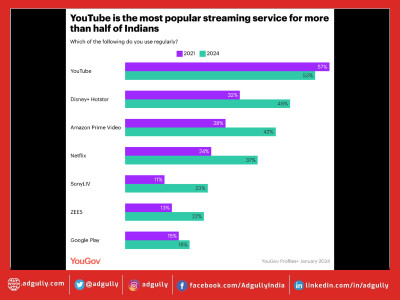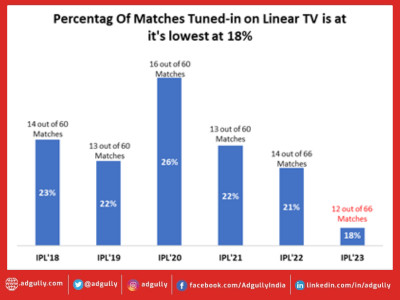PwC's report suggest internet to exceed TV by 2018
As internet penetration in India increases gradually, the medium understandably is in the league of becoming the first marketers and advertisers alike.
According to a recent research report published by PwC’s Global entertainment and media outlook 2014-2018 (Outlook) the total entertainment and media spending on digital services is forecast to grow at a 12.2% compound annual growth rate (CAGR) between 2013 and 2018 and account for 65% of global entertainment and media spending growth, excluding spending on Internet access. Advertising is leading the way; in 2018, 33% of total advertising revenue is forecast to be digital, compared to 17% of consumer revenue.
However, profiting from the migration by increasing revenue from digital consumers will not just be about the application of digital technology. It will be about applying a ‘digital mindset’ to build the right behaviours, advancing from a digital strategy to a business strategy fit for a digital age, according to PwC’s Global entertainment and media outlook 2014-2018 (Outlook).
Marcel Fenez, PwC’s Global leader, entertainment & media, says:
“The bedrock of a strategy fit for the digital age is the digital mindset: getting ever closer to the customer – across the entire organisation, and in everything it does. We now see that mindset embedded in many entertainment and media companies. But the industry needs to get even closer to the consumer and adopt more flexible business models. To do this, companies must exhibit three behaviours: forging trust with consumers; creating the confidence to move with speed and agility; and empowering innovation. This will be an important step in monetising the digital consumer.”
Approaching a significant advertising tipping point
Mobile Internet penetration will reach 55% in 2018, which will help drive digital advertising to increase its share of total advertising revenue to 33% by 2018, up from 14% in 2009. With Internet advertising growing at a 10.7% CAGR (compared to a total advertising CAGR of 4.4%), the industry is approaching a significant tipping point: in 2018, Internet advertising will be poised to surpass TV advertising. In 2009, TV advertising was double that of Internet advertising; in 2018, Internet advertising will trail TV advertising by just US$20bn. Mobile Internet advertising is forecast to grow at a CAGR of 21.5%.
Monetising the digital consumer: challenge and opportunity
Spending on digitally delivered content will account for only 17% of total consumer spending in 2018 (excluding spending on Internet access), compared to 33% of total advertising spending. However, the growth of ‘24/7 access’ and micro-transactions suggest that the key to monetising the digital consumer is to adopt flexible business models that offer more choices and better experiences. Electronic home video over-the-top (OTT)/streaming and digital music streaming are two of the fastest-growing consumer sub-segments cited in the Outlook, set to rise at annual rates of 28.1% and 13.4% respectively.
Nine markets driving growth
Nine high-growth markets are powering global entertainment and media revenue. China, Brazil, Russia, India, Mexico, South Africa, Turkey, Argentina and Indonesia collectively are forecast to account for 21.7% of global entertainment and media revenue in 2018, up from just 12.4% in 2009. Also in 2018, China will overtake Japan as the world’s second-largest entertainment and media market, behind only the US.
Marcel Fenez, PwC’s Global leader, entertainment and media, says:
“What all these markets have in common is a growing middle class boosting spending in entertainment and media. But the similarities stop there. Realising the revenue potential of these markets demands a deep understanding of the local context.Given their intimate local market knowledge, domestic organisations are in prime position to realise the opportunity of the emerging middle class The optimal approach for international players will most certainly be to collaborate with local partners.”
Advertising is spearheading the migration to digital as it follows eyeballs online:
• Internet TV advertising will double its share of total TV advertising revenue in the next five years. Internet TV advertising revenue from traditional broadcasters will increase from US$3.7bn in 2013 to US$9.7bn in 2018, and more than double its share of total TV advertising from 2.2% in 2013 to 4.5% in 2018. Traditional broadcasters still dominate and are adapting to the Internet video opportunity, creating a significant new revenue stream despite competition from Internet rivals.
• Mobile advertising will overtake classified Internet advertising in 2014. Global mobile Internet advertising revenue is forecast to leapfrog classified Internet advertising to become the third-largest Internet advertising channel with revenues of US$18.9bn in 2014. But after four particularly strong years, driven by the launch of a range of tablets, the annual rate of mobile revenue growth is falling back to the levels seen prior to their introduction. Advertisers now must do more than simply migrate large-screen banners to handhelds to sustain such growth.
• Digital consumer magazine advertising revenue is much larger than digital circulation. Global digital consumer magazine advertising revenue will be US$12.4bn in 2018, rising at a 17.6% CAGR; digital circulation revenue will be just US$5.7bn in the same year. This compares to a decline of -3.9% CAGR for consumer magazine print advertising revenue. Currently advertising is centred on magazine websites, but, as digital circulations increase, electronic editions will become increasingly popular for advertisers.
• Digital out-of-home (DOOH) advertising revenue will see significant growth in fast-growth markets. DOOH advertising is driving overall OOH advertising growth globally at a CAGR of 16.2%. However, in certain fast-growing markets, DOOH advertising revenue is forecast to grow even more rapidly, with CAGRs in excess of 30%. China is set to become the largest DOOH advertising market in the world by 2017.
Success in making money fromthe digital consumer can be found in offering choice and better experiences
• Subscription TV will not be daunted by the rise of OTT as it grows across global markets. Global subscription TV revenues (excluding licence fees) will grow at a CAGR of 3.5% over the next five years to US$236bn in 2018. This growth demonstrates that subscription TV is in a healthy position, assisted by the initiatives it has implemented to counter the impact of OTT and other disruptive influences.
• Box office resilience underscores the continuing popularity of cinema. Global box office revenue will exceed revenue from physical home video in 2014 and grow to US$45.9bn by 2018, from US$36.1bn in 2013, a 4.9% CAGR. In many growth markets, cinemas are being built to cater to the growing middle class.
• Digital newspaper payments are taking off, but won’t prove transformational. Digital newspaper circulation revenue grew by 66.2% through 2013. But although individual publishers report improved fortunes, few are hailing a transformation. Digital circulation will make up just 8% of total circulation revenue globally by 2018.
• Rising digital consumer revenue may be driven by 24/7 access. Two of the best-performing consumer sub-segments use a model in which consumers pay for round-the-clock access: digital music streaming revenue will grow at a 13.4% CAGR, and electronic home video OTT/streaming will rise at a 28.1%.These growth rates will not only offset a slow-moving non-digital consumer market, but may also point the way forward for other segments.
• Global electronic home video revenue will exceed physical home video revenue in 2018. Globally, the total combined revenue from OTT/streaming services and broadcasters’ video on demand services will grow at a CAGR of 19.9%. This will overtake physical home video revenue (the sale and rental of DVDs and Blu-ray discs) in 2018.
• Digital recorded music revenue will surpass physical recorded revenue in 2014. Global total digital recorded music revenue of US$10.18bn will exceed physical recorded music revenues of US$10.17bn for the first time in 2014. Greater service appeal for consumers will improve sales and by 2018, the year-on-year decline in total recorded music revenue will be just -0.1%.
• All-you-can-read subscription services are yet to take off but will be transformational. While they are still to gain traction, users of subscription services and aggregators will soon reach critical mass. With growing magazine circulations will come rising circulation and advertising revenue.
• Internet gaming is widening gaming participation and micro-transactions are helping to grow revenues. Internet gaming (including social gaming) has opened markets previously considered lost to piracy, with the business model enabling greater freedom and choice in how much gamers pay. China is the second-largest market for Internet gaming (US$4.2bn in 2013).In 2017, Russia) will overtake Germany to become the seventh-largest market for Internet gaming. Micro-transactions will help grow total video games revenues to US$89.0bn (6.2% CAGR) in 2018 and total console games revenues to US$31.9bn (4.9% CAGR) in 2018.
















Share
Facebook
YouTube
Tweet
Twitter
LinkedIn